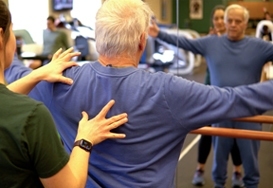With longer days and plenty of sunshine, most people more actively enjoy the outdoors during the summer months than during any other season. But with this increase in physical activity there is often an increase in injuries, which can put an abrupt end to your summer fun.
At Illinois Bone & Joint Institute, we have a veteran team of skilled physicians who know the precautions and protocols needed to keep you safe this summer. Here are three common injuries that occur during the summer months.
1. Water Sport Injuries
It’s an exhilarating feeling to rip through the water at 60mph with the wind in your hair and the water soaking your face. While the adrenaline rush is energizing, it’s easy to forget that you are a long way from help if something is to happen to you, so be sure to exercise caution when in the water.
While water sports are exciting, they can lead to serious injuries if you are not careful. Especially on windy days when the water can be rough, you may be thrown off and possibly suffer from a knee, ankle, and even back injury. In fact, many are not aware that the water can feel like concrete if you hit it at a high enough speed. If you have any sort of whiplash or discomfort after taking a hard fall in the water, it is important to seek medical help as soon as possible before an injury worsens.
Orthopedic surgeon Jeffrey Ackerman, MD, fellowship-trained in Adult Reconstruction, Joint Preservation and Resurfacing, points out “a fall while water skiing or wakeboarding can cause significant lower extremity injuries at the hip, knee, and ankle because of the forceful twisting of the leg that can occur when your foot is secured in the binding.”
Dr. Ackerman recommends that while ice and over-the-counter anti-inflammatories can calm down minor contusions or sprains; inability to bear weight on a lower extremity or pain lasting more than 48 hours should be addressed by an Orthopedic physician. “I have seen multiple fractures and ligamentous injuries this summer from these exhilarating high-energy activities.”
2. Running Injuries
Summer is also a great time to take to the streets or lakefront and enjoy a good run. While there is no fear of slipping on the ice during 90-degree heat, there are other possible risks. The avid runner can suffer from Runner’s Knee when overuse causes the kneecap to become out of alignment. Stress fractures of the foot are also common, as are ankle sprains and inflammatory conditions such as Achilles Tendonitis and Plantar Fasciitis.
In an effort to prevent such injuries, Ari Kaz, MD, a board-certified orthopedic surgeon fellowship-trained in Foot and Ankle Orthopedics, states “I encourage runners to wear good supportive running shoes, to warm up and cool down appropriately, and to gradually increase their mileage. It’s also important to take a day off between runs, and if you develop knee, ankle, or foot pain that does not resolve after a few days of rest, it may be prudent to have it checked out by your local IBJI orthopedic surgeon,”
3. Bicycle Injuries
While cycling is a great summer activity, it can cause a lot of strain to different areas of your body. For cyclists, it is important that your feet are properly fastened or the result will be a sharp lingering pain in the knees, and make sure the bottoms of your footwear are tightly attached to the pedals.
“Biking in the city can be especially dangerous,” notes David Garelick, MD, a board-certified orthopedic surgeon fellowship-trained in Sports Medicine. “In addition to the stress and strain from a long ride, watch out for an unexpected opening of a car door. Getting ‘doored’ is probably the most frequent bike injury I see which can lead to severe upper extremity injuries.”
If you’re planning a long bike ride, you will spend an extended period of time in the same position, putting stress on your lower back and spine. To help avoid this, adjust your bicycle to fit your body and be mindful of your posture on your ride.
If you think you may have suffered an injury, please be sure to contact your nearest Illinois Bone & Joint Institute location immediately for further assistance.
*This content is for information only and is not intended to replace the diagnosis, treatment, or medical advice from your treating healthcare professionals. The content does not provide medical advice, does not constitute the practice of medicine or other healthcare professional services, and does not create a doctor-patient relationship. You should not rely on this information as a substitute, nor does it replace professional medical advice, diagnosis, or treatment. If you have concerns or questions, seek the advice of your healthcare professionals. If you think you may have a medical emergency, call your doctor or 911 immediately. Do not rely on electronic communications or communicate through this website for immediate, urgent medical needs. This website is not designed to facilitate medical emergencies. The use of the information is at the reader’s own risk. The links are provided for information and convenience only. We cannot accept responsibility for the sites linked or the information found here. A link does not imply an endorsement of a site.




